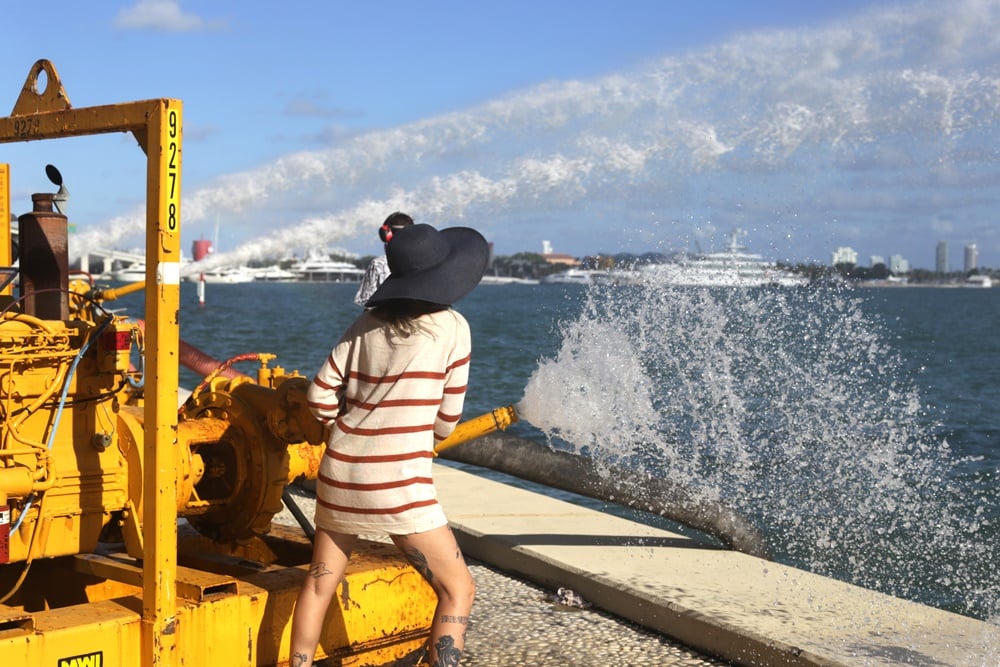
Can an artist help tackle one of the biggest problems facing mankind?
Miami Beach certainly thinks so. One of the most vulnerable cities in the United States to the effects of climate change, the metropolis has launched an innovative artist residency that aims to recruit an artist to help address rising sea levels. For one year, the artist will be embedded with the city as it works to develop a plan to respond to the rising tides.
In Miami Beach, climate change isn’t just a nerve-wracking impending problem—it’s a reality. Sea level rise has tripled over the past decade and the city has resorted to importing sand in order to restore its rapidly eroding coastline. In 2015, Miami Beach committed to investing $500 million to raise roads and install pumps to protect the island and its residents. The city’s Bass Museum has already altered its collecting strategy to focus on more durable objects in lieu of delicate, humidity-sensitive works on paper and photographs.
Misael Soto, Flood Relief (2017) at Museum Park, Miami, Florida. Seawall adjacent to Pérez Art Museum. Courtesy the artist.
So why ask an artist to help address this very urgent problem? “I’ve always found it ingenious how artists think about not only physical projects, but also things such as policy decisions and ways to inform the way the public engages and thinks as well,” Miami Beach cultural affairs manager Brandi Reddick told artnet News.
After putting out an open call to artists that drew more than 100 proposals from around the world, the city chose a local resident, Puerto Rican-born, South Florida native Misael Soto, to fill the slot. Over the next twelve months, he will attend meetings with city officials, provide input, and create art that seeks to bring the community into the process of addressing climate change.
“It really seemed tailor-made for me,” said Soto, who just wrapped up his MFA at the School of the Art Institute of Chicago. He was particularly intrigued by “the ability to get into the city government on the municipal level and interacting directly as opposed to from afar.”
The new residency is the brainchild of the Art Center of South Florida, which has been offering artist residencies for the past 37 years, in conjunction with the city of Miami Beach. “There really isn’t any other program like this that I know of,” Soto noted.
Art Center president and CEO Dennis Scholl told artnet News that with the help of the Knight Foundation, “we were able to create a residency that would bring an artist to South Beach and embed him or her in city government. In this case, the city liked the idea so much that they were willing to have the artist embedded in the resiliency department of the city of Miami Beach.” Resiliency, he added, is “code word for the things that concern us here… South Beach is ground zero for rising sea levels.”
According to an initial post about the residency, the program offers a $25,000 stipend, housing, and a maximum of $7,500 for production.
Misael Soto in collaboration with Ayesha Singh, Provisional Obstruction (2017). Courtesy the artists,
Soto isn’t the only artist to embed himself in a municipal government. New York City, for example, offers artist residencies in departments as diverse as the Department of Sanitation and the Department of Probation.
Meanwhile, other institutions have recognized artists’ potential for thinking creatively about climate change. Justin Guariglia, for example, has ridden aboard expeditions with NASA as they track the sinking ice sheets over Greenland. Scientists hope he can help them better visualize the topography of Greenland’s ocean floor.
For his part, Soto is well positioned to join Miami’s fight against the rising tides. He already has experience making art on the city’s shoreline. This past November, he created Flood Relief at Miami’s Museum Park, adjacent to the Pérez Art Museum. The week-long installation employed numerous gas-powered pumps to Sisyphean effect: They created a continuous cycle of water pumping out and then funneling back into Biscayne Bay. Stripped of their original purpose, they “essentially become fountains,” the artist explained.
Soto’s other major projects—installed in Florida and other East Coast locations—include Beach Towel (2011–12) and Picnic Blanket (2012), for which he created giant versions of the titular objects and turned them into sites where guests could play games, eat, and gather. The projects aimed to change the way beach- and park-goers think about the space they occupy, he said.
Soto’s residency began in Miami Beach a few weeks ago with meetings with various stakeholders. The particular projects he will focus on likely won’t be finalized until the fall. “Don’t ask me what he’s going to do, because I don’t know,” Scholl said.
Soto says he is aiming to identify three or four sites across Miami Beach and spend a few months at each site “in a kind of shifting installation that plays with these signifiers of public works improvement.”
Scholl said he would like to see more cities give “artists a seat at the table” to help solve big problems creatively. Though in this case, that table won’t stay in one place—it will be roving around the city for the next year. “This isn’t a residency where you’re locked in a studio with a blank canvas for 12 months,” Scholl said.